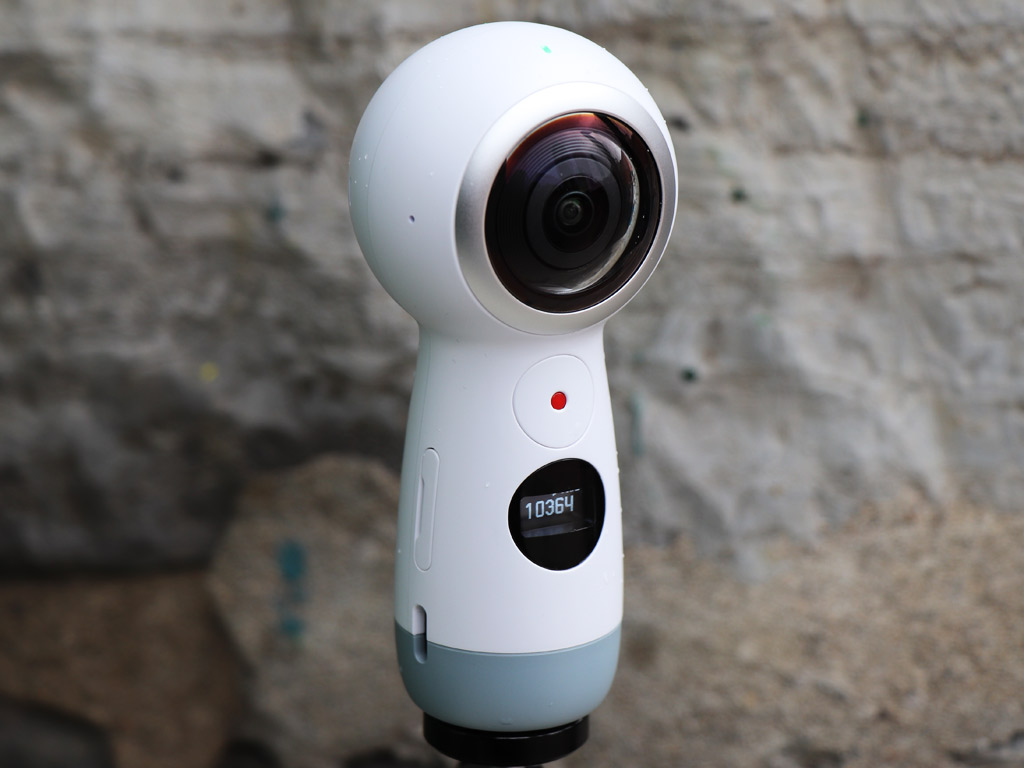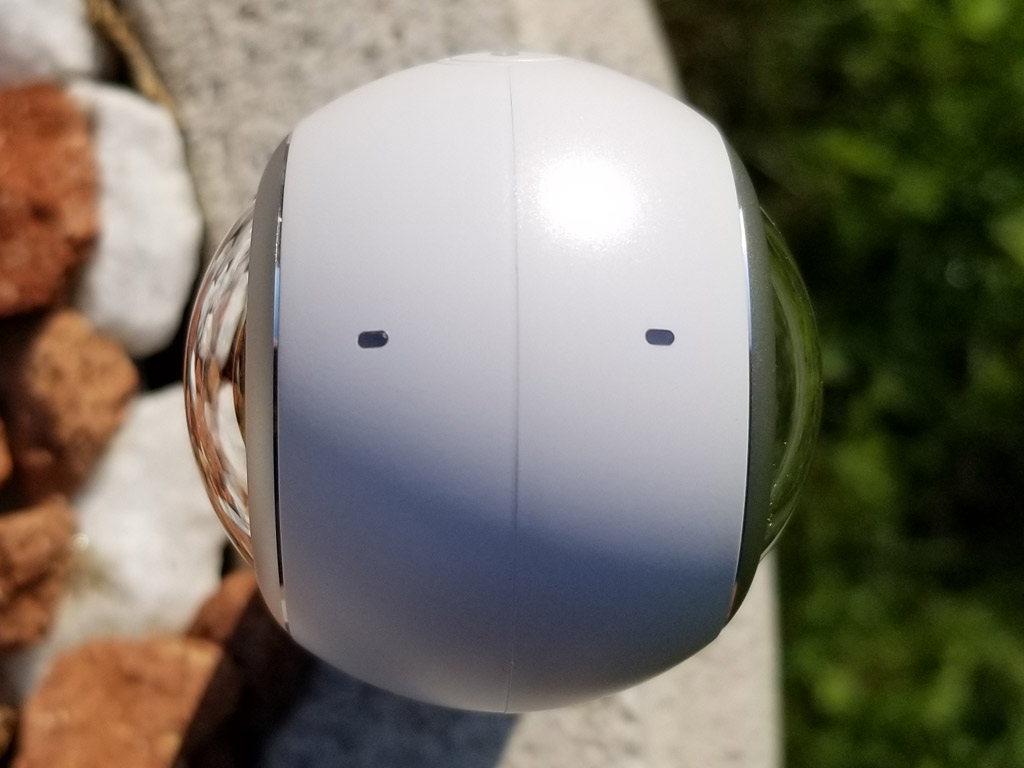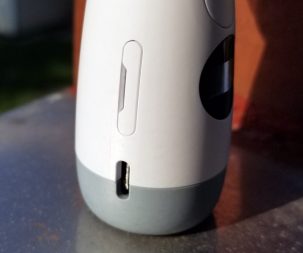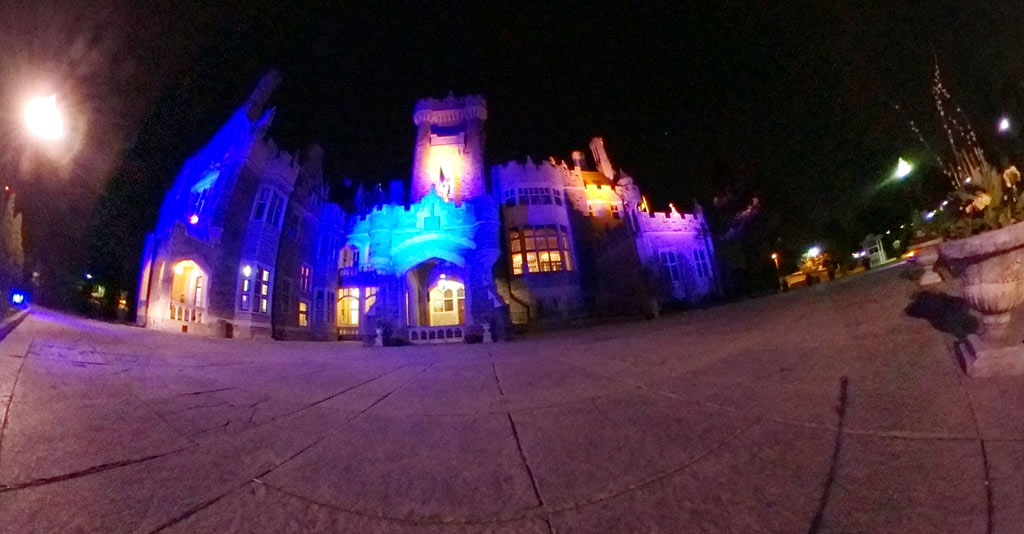
Shooting photos or video in 360-degrees is a perspective unlike any other in imaging, and Samsung has made it a little easier to wield its latest Gear 360 camera.
This is a new iteration of last year’s model, Samsung’s first-ever foray into 360-degree devices. A number of things have been changed to accommodate the different form factor for this year’s Gear 360.
New Gear 360 look
Last year’s design was slightly smaller than a tennis ball, with a short detachable tripod that came included in the box. The tripod doubled as a handle to shoot by hand, making it a neat dual-use accessory.
Samsung effectively combined the two by making the ball smaller and adding a short stem for a one-piece design that does two things. First, it brings the two lenses closer together, and second, it creates some elevation to capture more in the lower half of the overall picture. There’s still a screw mount underneath to attach to a tripod or selfie stick, but neither of those come with the unit.
This Gear 360 could stay upright on its own with some elevation because of that stem. To help with that, a rubber donut with a lanyard is included to add some extra stability. Since it can be tied to the carabiner on the camera itself, it’s not an accessory easy to lose.
Going with this design also changed placement. The small OLED display and record button are on the stem, along with a slot for the microSD card and an exposed USB-C charging port. The back and menu buttons are on the ball between the lenses on one side. The IP53 rating is the same as the previous model, meaning it can handle a sprinkle from rain or splashes, but it not water-resistant, much less waterproof.

Changes inside
 Given the overall form factor is smaller than its predecessor, the two lenses on this Gear 360 are also smaller. That required using smaller image sensors, equating to dual 8.4-megapixel sensors totaling 15-megapixel spherical images and video. That’s half of what the previous model could output.
Given the overall form factor is smaller than its predecessor, the two lenses on this Gear 360 are also smaller. That required using smaller image sensors, equating to dual 8.4-megapixel sensors totaling 15-megapixel spherical images and video. That’s half of what the previous model could output.
The f/2.2 apertures are slightly tighter, compared to the f/2.0 from before, which makes it a little tougher for light to seep through low-light situations.
The main point Samsung has made is in raising the shooting resolution up to 4K (4066 x 2048), though it only works in 24fps for video files (in H.265).
Shooting at higher resolutions naturally takes up more space, and a memory card is a must, since there is no internal storage here. The camera can handle up to 256GB cards, double the max of the previous model
Performance
Shuffling through the menu on the OLED display felt much the same as it did previously, only that it was easier to make a quick adjustment while shooting. The Gear 360 app remains the best way to manage the device, especially since it offers a live view and access to all the device’s settings. That Samsung included iPhone support is a nice overture to a wide swath of users. The iOS app is robust too, offering just about everything the Samsung one has, except for a key feature that I’ll touch on later.
Though there was talk about including all Android devices running version 5.0 Lollipop or later, that had yet to happen at the time of this review.
Even though 4K is limited to 24fps, where fast action doesn’t necessarily turn out extremely well, you can still shoot in 2K at 60fps, providing better results. Shooting 24fps is much better for slow-moving images or capturing static environments.
Both lenses can shoot simultaneously, where the software will stitch them together later, or choose one to shoot at 180-degrees. Shooting mode options include video, photo, time-lapse video, looping video and landscape HDR still images.


Ultimately, overall quality is not as good as the previous model, but it does depend on what, when and how you’re shooting. For example, daytime images will come out fine, and even better if the camera is sitting still on a flat surface or tripod. Selfie sticks work too, allowing you to capture scenes in a variety of ways.
As before, zooming out on a stitched 360-degree photo or video tends to look sharper and more dynamic. Zoom in, and the sharpness loosens noticeably. That’s actually pretty normal at this stage for 360-degree cameras, and even more so when there’s been an overall drop in resolution.
The limitations are especially noticeable at night or low-light situations because the camera has to boost ISO and lower shutter speed considerably to get a decent shot. Keeping it on a tripod or flat surface makes it much easier to shoot with a slower shutter, but cranking up the ISO invites noise to creep in. In short, you can get an image that is usable, but I wouldn’t expect anything outstanding.
Another caveat to point out is that still 180-degree photos from only one of the two lenses max out at 3-megapixels. That’s not terribly high by today’s standards, so if you’re going to do it, make sure the most important part of the shot is in the middle.
Battery life and streaming
It’s hard for me to put an exact number on battery life. The battery inside isn’t removable like it was with the previous model, but it is smaller at 1160mAh (compared to 1350mAh). Assuming you shoot in shorter spurts, the camera can probably keep going for a few hours or more before needing a recharge. Shooting longer will sap it faster.
Even so, the biggest battery drainer is actually the Wi-Fi Direct and Bluetooth connection with the Gear 360 app. Live viewing from the camera, stitching images together and transferring them to the phone take up juice. Transferring content, especially at 4K resolution, does take longer, so it’s generally better to shoot everything first and then do the transfers later.
The one feature missing from the iPhone app is live streaming. This is a feature Samsung has played up, and it works with YouTube, Facebook and Samsung’s own Gear VR service. It’s neat, but can be dangerous to your monthly data plan, so I recommend trying to do it with Wi-Fi available, or limit it to very short clips.
Final thoughts
A key reason this Gear 360 works more fluidly than the previous one is because it’s pocketable. I had a much easier time carrying it around and holding onto it, which is half the battle when using imaging equipment.
The thing is, the slimmer frame means there is a trade-off in output. The stitching is better, except the overall fidelity generally isn’t. What you have is a more convenient way to shoot in 360-degrees at the expense of some quality. It might come off as a tough trade to make, but 360-degree imaging is still fairly new and this is considered a mid-range device in that category.
The Samsung Gear 360 (2017 Edition) is available now.


